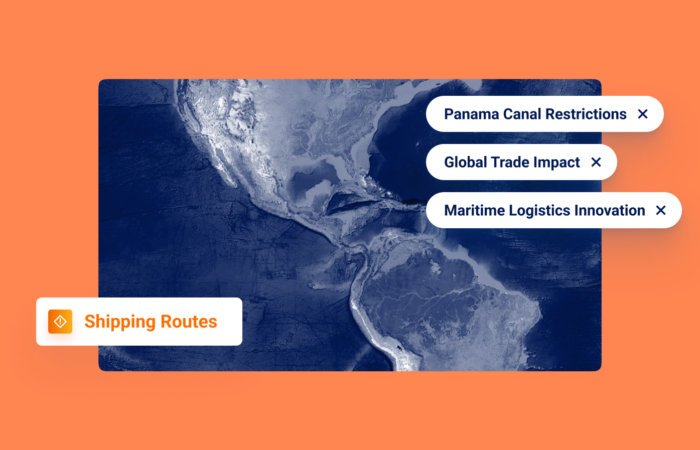What’s inside?
During this difficult period, when supply chain reliability is low and the chance of delay is high, logistics providers are looking for a solution to automate their workflows, improve the quality of their shipping data, and help provide their customers with the most accurate insights. It is challenging for logistics providers handling freight forwarding to maintain a level of service excellence, especially at capacities of 100,000 TEUs and above.
A McKinsey article from the spring of 2022 sums up the state of the supply chain and pressure points:
“Global supply chains have seen unprecedented disruption, and container freight rates are at record highs. COVID-19 led to a boom in U.S. containerized consumer goods demand, causing congestion, and reducing effective container logistics capacity. Global container shipping rates have, on average, increased to four to five times their 2019 levels while some spot markets have seen even higher rates. Shippers have struggled to locate capacity, with acute shortages of vessel space, container boxes, chassis, warehouse space, intermodal capacity, and labor. Shippers that managed to find access to the constrained capacity have experienced record low reliability both at sea and on land. Average container schedule delays have doubled globally, and increased by six times on the Far East and North America trade from two days in the first quarter 2020 to 12 days in the last quarter of 2021.”

Automating Workflows – Improving Efficiency
Let’s call it “Amazonification” – customers of all types now expect to know where packages are at every step of the journey, with accurate ETA predictions. They don’t tolerate excuses. Windward’s Co-Founder and CEO, Ami Daniel, summarized this new landscape in Forbes:
“Hundreds of thousands of freight forwarders in the world are now being increasingly expected to deliver an Amazon-like experience—which is a herculean task with today’s supply chain. The logic goes that if you know when your Amazon shipment is coming, and you get that for free, why can’t you know when the containers you are moving on behalf of your customers will arrive or how much it will cost?
That, coupled with the accelerated digitalization of the industry and pressure from different vertically integrated visibility platforms and digital freight forwarders, is leading to elevated expectations from service providers in the logistics space.”
Unfortunately, according to Ami, many organizations in the ocean freight ecosystem are far from this ideal:
“If you work in logistics—managing a supply chain at a shipping company (also known as a BCO) or as a logistics professional at a freight forwarder—you might have to use multiple IT platforms that are sometimes 20 years old. Team members are constantly on the phone, data is transferred very slowly in a cumbersome way, and communication with customers is based on antiquated-looking reports and printouts. So while your personal iPhone is blazing, your work PC is way behind in every possible way.”
Expectations for customer service in the shipping industry are high and freight forwarders need to ensure their customer service rises to that level. Accurate ocean freight visibility is crucial for shippers to know where their cargo is located and when it’s expected to arrive. In an industry where freight forwarders receive limited information from carriers, they are forced to invest a significant amount of money and resources into chasing answers for their customers.
This manual process, as described in a previous blog post, limits the freight forwarder to two unappealing options:
- They will need to wait for the port to update the information on their website, and then the carriers would have to check the port website to see which ships have arrived, or called port. The freight forwarders would then be required to update their website or communicate this information with their customer. This process is time-consuming, inefficient, and occasionally inaccurate.
- They’ll need to call the port directly and ask if the specific vessel has arrived, and then update the customer. Again, this is a time-consuming process.
Accurate and Reliable Shipping Data – Improved Customer Satisfaction
Logistics providers believe in digitalization-first and seek a more effective and efficient solution that will automate their workflows and improve the quality of their maritime data, without using multiple platforms.
Using AIS shipping data alone isn’t enough and freight forwarders need a marine data solution that fuses shipping data from multiple maritime data providers and leverages advanced algorithms and maritime domain expertise to deliver actionable insights.
Having multiple marine data providers is key to getting the most accurate insights. The more shipping data the deep learning (an artificial intelligence model) has, the more accurate the output (results) will be. This, in combination with an API Insights Lab like Windward’s, provides automated updates that the freight forwarder or shipper can manage directly in their existing workflows, and always know – with the help of Maritime AI™ predicted ETAs – which shipments are at risk of arriving significantly later than expected.
The Outcome
Implementing a solution like Windward’s Ocean Freight Visibility can have an incredible effect on both shippers’ and freight forwarders’ efficiency and customer satisfaction, enabling the team to eliminate nearly all of their manual processes related to finding and updating ETAs. This enables the customer service team to spend more time-solving customers’ logistics challenges, providing excellent service, and deepening relationships with them. Financially, it reduces operational costs, like dwell time and demurrage charges, that are caused by supply chain delays.






